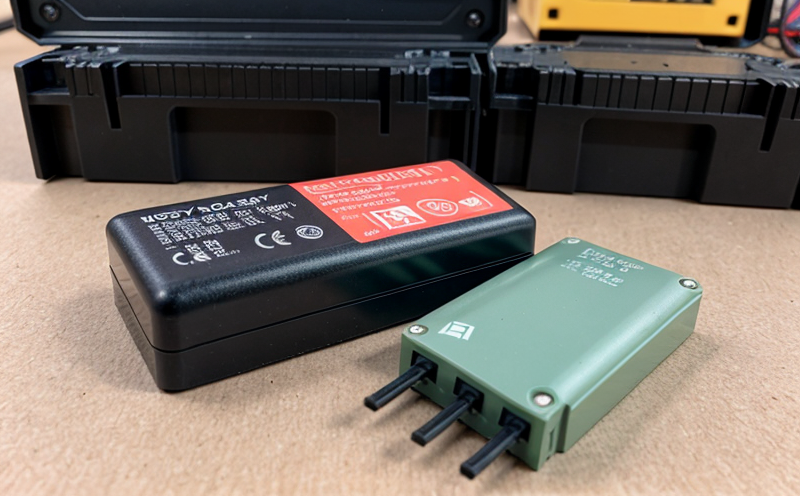SAE J2380 Battery Pack Vibration and Performance Testing
The SAE J2380 standard is a critical benchmark for ensuring the durability, reliability, and safety of battery packs in electric vehicles (EVs) and other applications. This test evaluates how well a battery pack performs under simulated road conditions that include vibrations, temperature fluctuations, and electrical stress. It ensures that manufacturers meet regulatory requirements while also improving product quality.
The SAE J2380 protocol is designed to simulate the real-world stresses faced by electric vehicle batteries during operation. By subjecting the battery pack to controlled vibrations and performance tests, engineers can identify potential weaknesses or design flaws early in the development process. This proactive approach helps manufacturers avoid costly recalls and enhances consumer confidence.
The test setup typically involves a fully assembled battery module or pack placed on a shaker table that simulates the dynamic loads encountered during vehicle operation. The battery is then subjected to various environmental conditions, including temperature cycling from -40°C to +85°C, as well as high and low humidity levels.
During the test, the performance of the battery pack is continuously monitored using data acquisition systems that track voltage, current, internal resistance, and temperature. These metrics are recorded at regular intervals throughout the duration of the test. The results provide valuable insights into how well the battery holds its charge over time under extreme conditions.
The SAE J2380 protocol is particularly important for electric vehicle manufacturers who must comply with stringent safety regulations. By adhering to this standard, they demonstrate their commitment to producing safe and reliable products that meet industry standards. Additionally, compliance with SAE J2380 can provide a competitive edge in the market by differentiating high-quality products from those that do not meet these rigorous testing protocols.
In summary, the SAE J2380 Battery Pack Vibration and Performance Testing is an essential tool for ensuring the longevity and reliability of battery packs used in electric vehicles. It helps manufacturers identify potential issues early on, ensures compliance with regulatory requirements, and enhances overall product quality.
Applied Standards
- SAE J2380
- ISO/TS16949
- IEC 62132-1:2017
- ASTM D5456
The SAE J2380 standard is widely recognized and accepted in the automotive industry. It ensures that battery packs used in electric vehicles are subjected to realistic stressors, thereby enhancing their durability and reliability. Compliance with these standards not only meets regulatory requirements but also contributes to the safety and performance of EVs.
ISO/TS16949 focuses on quality management systems for the automotive industry, ensuring that all processes related to the design, development, production, installation, and service of products are controlled. This standard helps manufacturers maintain consistent quality across their operations.
The IEC 62132-1:2017 specification covers the structural requirements and test methods for lithium-ion cells used in electric vehicles. It provides guidance on how to conduct tests that assess the mechanical integrity of these cells under various conditions, including vibration and impact.
ASTM D5456 specifies procedures for determining the thermal decomposition temperature (TDT) of organic materials using differential scanning calorimetry (DSC). Although primarily used in material science, this standard can be referenced when evaluating the thermal stability of battery components.
Scope and Methodology
The SAE J2380 Battery Pack Vibration and Performance Testing involves several key steps to ensure accurate results. First, the battery pack is prepared according to manufacturer specifications, ensuring that all components are assembled correctly before testing begins.
Once the battery pack is ready, it is placed on a shaker table where it undergoes controlled vibrations simulating those experienced during vehicle operation. The frequency and amplitude of these vibrations can be adjusted based on specific requirements set forth by SAE J2380. Simultaneously, environmental conditions such as temperature, humidity, and altitude are precisely controlled to mimic real-world driving scenarios.
Throughout the test period, various parameters are continuously monitored and recorded using advanced data acquisition systems. These include voltage, current, internal resistance, and temperature. Additionally, visual inspections may be conducted periodically to check for any signs of damage or degradation.
The duration of the vibration phase typically ranges from several hours up to multiple days depending on the specific test requirements. After completion, the battery pack undergoes performance evaluations to assess its ability to maintain consistent output power and energy efficiency despite exposure to harsh environmental conditions.
Finally, after thorough analysis of all collected data points, a comprehensive report is generated detailing the findings from each aspect of the testing process. This document serves as evidence that the battery pack meets or exceeds expectations regarding both performance capabilities and safety standards established by relevant organizations like SAE J2380.
Why Choose This Test
- Ensures compliance with international standards
- Identifies potential issues early in the development process
- Improves overall product quality and reliability
- Enhances consumer confidence through demonstrated safety measures
- Provides valuable insights into real-world performance under various conditions
- Aids manufacturers in meeting regulatory requirements for electric vehicle batteries
- Differentiates high-quality products from those that do not meet rigorous testing protocols
- Helps ensure consistent quality across all aspects of the manufacturing process
Selecting SAE J2380 Battery Pack Vibration and Performance Testing offers numerous advantages for manufacturers seeking to enhance their product offerings. By adhering strictly to this standard, companies demonstrate their commitment to producing safe, reliable, and high-performing electric vehicle batteries.





